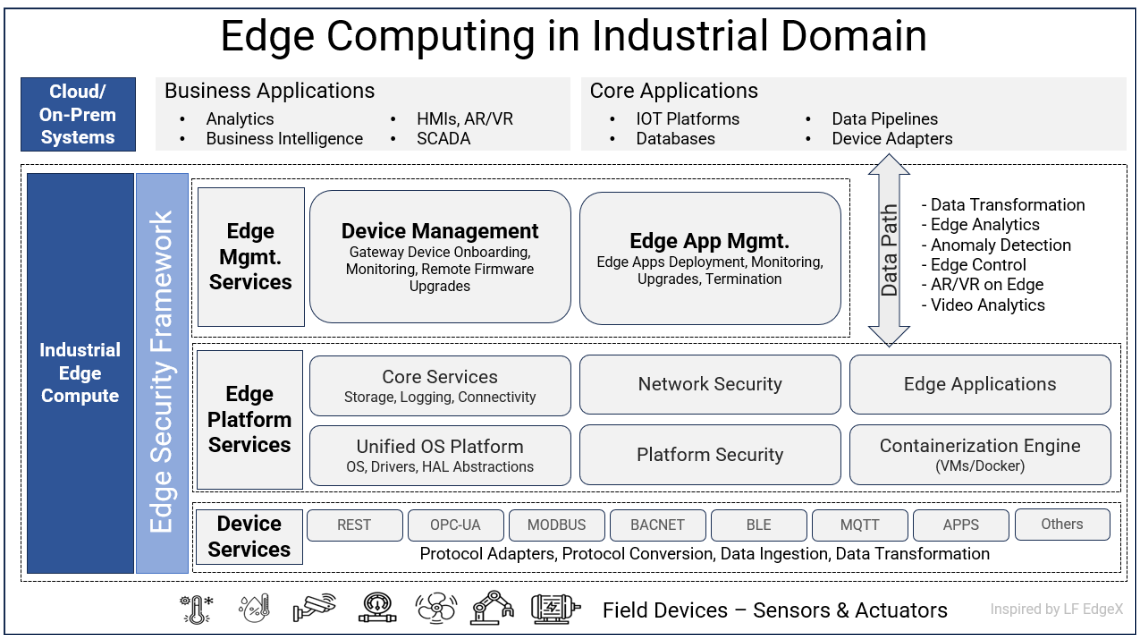In the fast-evolving landscape of technology, Edge Computing has emerged as a revolutionary paradigm, transforming the way data is processed and applications are deployed.
This shift from traditional cloud-centric models to decentralized, edge-focused architectures has been particularly pivotal in the industrial domain.
As industries embrace the era of Industry 4.0, the need for a robust computing architecture at the edge becomes more apparent than ever.
Importance of a Robust Edge Computing Architecture
The industrial domain operates in a dynamic environment where real-time data processing, low-latency applications, and efficient resource utilization are critical.
A robust computing architecture tailored to the industrial setting not only enhances operational efficiency but also lays the foundation for the integration of cutting-edge technologies like the Internet of Things (IoT) and Artificial Intelligence (AI).
Today, we shall explore world of Edge Computing Reference Architecture – a comprehensive framework designed to address the unique challenges and requirements of the industrial landscape.
Layered Architecture for Edge Computing
A layered architecture for edge computing is crucial as it provides a structured and modular approach to design, develop, and manage complex systems.
This approach offers several benefits, including:
- Modularity and Scalability: Layered architectures allow for the development and maintenance of modular components. This modularity enhances scalability, making it easier to add or upgrade specific functionalities without affecting the entire system.
- Abstraction of Complexity: Each layer abstracts the complexities of the underlying components. This abstraction simplifies development, enhances maintainability, and facilitates easier integration of new technologies or updates.
- Interoperability: Clear separation of layers promotes interoperability. Devices and services within a layer can communicate seamlessly, and changes in one layer do not necessarily impact others, ensuring compatibility across diverse components.
- Security: By segregating functionalities into layers, security measures can be implemented at each level. This multi-layered security approach provides defense in depth, protecting the entire system from various potential threats
- Flexibility in Technology Adoption: As technology evolves, a layered architecture allows for the adoption of new technologies in specific layers without disrupting the entire system. This adaptability is crucial for staying current with technological advancements
Edge Computing Architecture
Now, let's briefly understand the following broad layers of the Edge Computing Architecture:

Device Services
The Device Services layer is the interface between the edge devices and the rest of the edge architecture. It manages communication protocols, data ingestion, and transformation, ensuring that data from diverse devices is processed and prepared for further analysis.
Key Components Include:
- Protocol Adapters: Enable communication between devices using different protocols.
- Data Ingestion: Collect raw data from devices.
- Data Transformation: Refine and structure data for efficient processing.
Edge Platform Services
Serving as the backbone of the edge infrastructure, the Edge Platform Services layer provides core functionalities for storage, connectivity, security, and application execution.
It also supports the deployment and management of edge applications in a standardized environment.
Key Components include:
- Core Services: Manage essential infrastructure functions.
- Unified OS Platform: Ensure a consistent operating system for edge devices.
- Edge Applications: Host and execute applications tailored for the edge.
- Containerization Engine: Facilitate the deployment of containerized applications.
Edge Management Services
The Edge Management Services layer focuses on the efficient management of edge devices and applications. It streamlines onboarding, monitoring, and maintenance processes to ensure the health and performance of the entire edge ecosystem.
Key Components include:
- Device Management: Facilitate onboarding, monitoring, and remote firmware upgrades.
- Edge App Management: Oversee the deployment, monitoring, and upgrades of edge applications.
Cloud/On-Prem Systems
This layer extends beyond the edge, encompassing centralized systems, whether in the cloud or on-premises. It is responsible for applications that benefit from broader data analysis, business intelligence, and scalability.
Key Components Include:
- Business Applications: Support analytics, business intelligence, and other enterprise-level applications.
- Core Applications: Manage databases, data pipelines, and device adapters that facilitate communication between edge and centralized systems.
Conclusion: The Edge Computing Reference Architecture
In conclusion, the Edge Computing Reference Architecture in the industrial domain stands as a testament to the transformative power of technology in shaping the future of industries.
The layered architecture, with its meticulously designed Device Services, Edge Platform Services, and Edge Management Services, provides a structured and modular framework that not only addresses the unique challenges of the industrial landscape but also paves the way for innovation and efficiency.
The importance of this architectural approach lies in its ability to offer modularity, scalability, security, and flexibility, fostering a dynamic ecosystem where devices, platforms, and management services seamlessly collaborate.
As industries continue to embrace the era of Industry 4.0, this holistic approach to edge computing architecture ensures a resilient foundation for the convergence of cutting-edge technologies, enabling industries to thrive in the digital age.